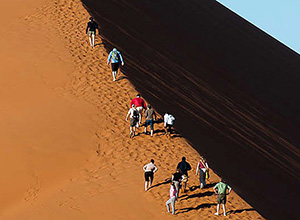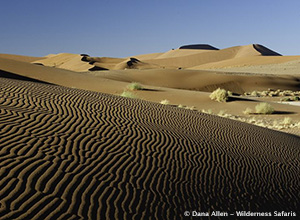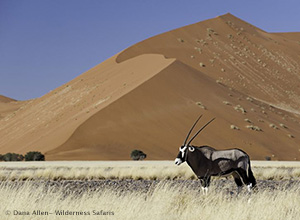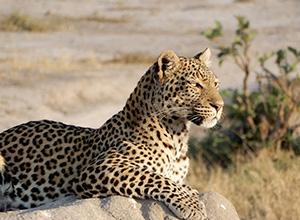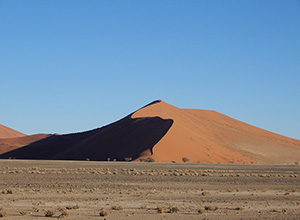Namibia Safari Attractions
Damaraland and Kaokoveld
Damaraland and Kaokoveld demand a certain level of respect. Beautiful, but arid and unforgiving, attractions near this area have names like Burnt Mountain, the Petrified Forest, the Skeleton Coast - all aptly named and an indication of the drama found here. Occupying a huge, harsh stretch of landscape to the northwest of the country, even the people and wildlife have adapted accordingly.
The Himba, a tall, slender and statuesque people, rub their bodies with red ochre and fat to protect their skins against the climate. Desert adapted elephants have special behavioral characteristics, large annual and seasonal ranges and a social structure and daily activities to cope with the environment.
Thankfully for visitors, there are many great desert accommodation options, which means you don't have to rough it in Damaraland and Kaokoveld in the slightest.
Etosha National Park
One of the worlds finest game parks. Location of some familiar wildlife, Etosha is home to all of Africas Wildlife "big five" - lion, leopard, buffalo, rhino and elephant. Springbok, wildebeest, eland and zebra range the park and congregate at the water holes in large numbers especially during the dry months of June to December. There are good numbers of lion and leopard and black rhino.
Namib Desert
Namib Desert stretches for nearly a 1000 km along the Atlantic coast. As one of the oldest deserts in the world, its sand takes on a distinctive rust colour and it has some of the highest sand dunes in the world.
Sossusvlei
Sossusvlei means "the gathering place of water" though seldom will you find water here. Instead you'll find the highest sand dunes in the world and perhaps Namibia's most outstanding scenic attraction.
These dunes, part of the Namib Desert, have developed over a period of many millions of years. The result of material flowing from the Orange River dumped into the Atlantic Ocean, carried northward and then returned again to land by the surf. Here the wind continuously shifts the sand further and further inland, reshaping patters in warm tints that contrast vividly with the dazzling white surface of the large deflationary clay pans at their bases. Climbing up one of these dunes provides breathtaking views of the whole area, including Deadvlei, a large ghostly expanse of dried white clay punctuated by skeletons of ancient camelthorn trees, carbon dated between 500-600 years old.
The best time to view Sossusvlei is close to sunrise and sunset when the dunes refract spectacular colors, ranging from burnt orange, red and deep mauve. It's a photographer's dream.
Swakopmund and Walvis Bay
Swakopmund is Namibia's playground, a holiday destination for tourists and locals alike looking to escape the heat of the interior and to have a little adventure.
The city itself resembles a small German town and manages to create a feeling of timelessness with its palm-lined streets, seaside promenades, restaurants, cafes, art galleries and museums. And while there's plenty to do within city limits, the real action happens in the desert surrounding Swakopmund. Quad-biking, sand-boarding, sand-skiing, parasailing and dozens of other guided adrenaline inducing activities are available by reservation from many of the adventure companies operating in the area. At Walvis Bay, visitors can join a dolphin cruise or explore the lagoon on a kayak tour.
Even with all this excitement Swakopmund serves as a good break during a busy vacation. Relax and have fun in a place well suited for both.
The Skeleton Coast
Once upon a time the entire coastline of Namibia was called The Skeleton Coast. Today, the moniker mostly refers to the Skeleton National Park, which stretches the northern one-third of Namibia's shore. The landscape in the park ranges from wind swept dunes to rugged canyons with walls of richly colored volcanic rock and extensive mountain ranges.
The park's ominous name is well earned given the scores of shipwrecks littering the beaches - the work of the Benguela Current, dense fog and rough surf. Bleached whale and seal bones also are visible back from days when the whaling industry was still active. But despite its appearance, the Skeleton National Park houses a great variety of species with its borders - big cats, desert-adapted elephant, black rhino and many more.
You're best to fly-in to see everything, especially the vast display of shipwrecks, but you can also enter between the Ugab and Hoanib rivers and enjoy the coast's superb fishing area.





